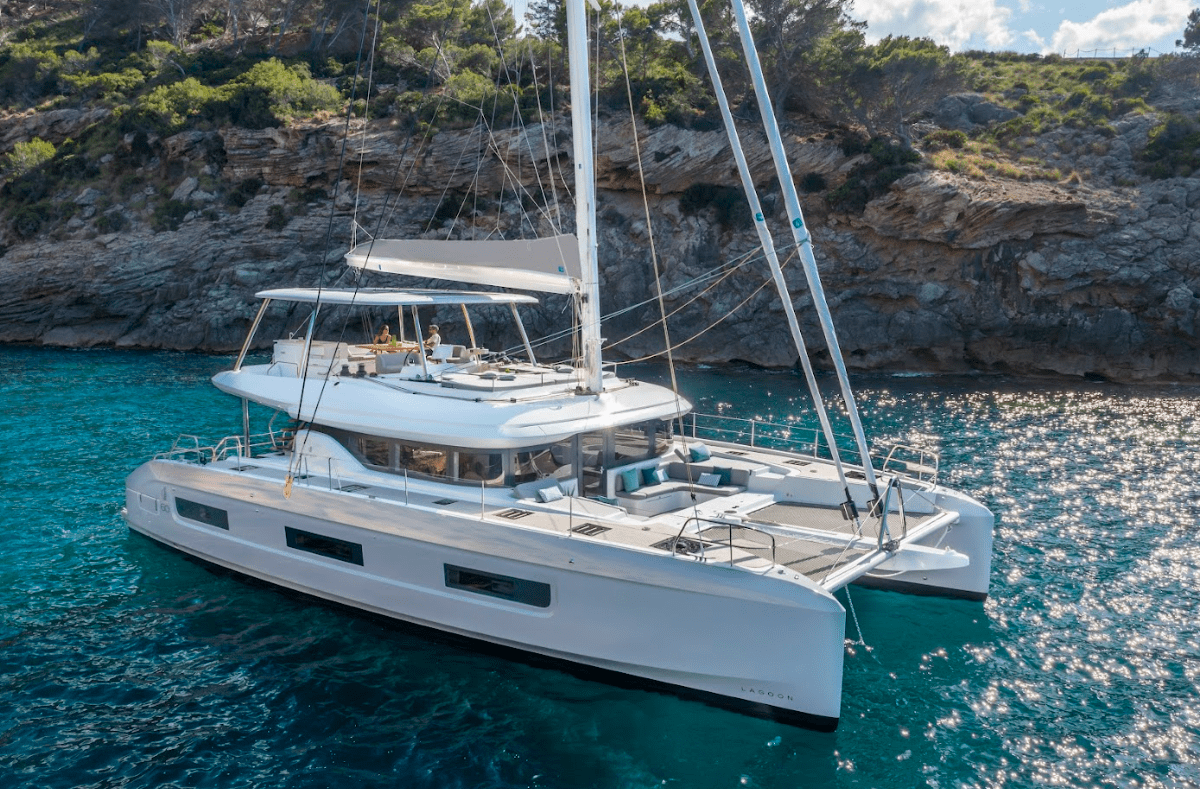 Lagoon’s latest flagship takes cues from its 620 predecessor with innovative enhancements.
Lagoon’s latest flagship takes cues from its 620 predecessor with innovative enhancements.
Lagoon, the leading manufacturer of cruising multihulls (with 7,000 units produced since 1984), didn’t fully utilize all its creative concepts during the height of the COVID-19 pandemic. As market conditions have become more challenging, the manufacturer is now launching two new cruising catamarans, the 43 and the 60, both debuting at the forthcoming Cannes Yachting Festival (September 10–15, 2024).
We had the opportunity to explore the larger model, now the flagship of the “standard” range, in the pristine waters off the northern coast of Menorca, Spain.
Replacing the previous first-in-class model posed significant challenges. The legacy of the 620 loomed large over the 60, with 169 units sold prior to the launch of the Premium version, which was a resounding success.
Back in March, at the Bordeaux facility where all Lagoon yachts over 50 feet are constructed, we observed the initial presentation of the Lagoon 60. Here, it was evident that all the hallmark features of the 620 had been retained and optimized to align with contemporary standards. We were eager to witness these enhancements firsthand.
Brand manager Thomas Gailly and product developer Bruno Belmont greeted us at Fornells Bay, Menorca.
 The Lagoon 60 was anchored in Menorca, with Lagoon’s team aboard.
The Lagoon 60 was anchored in Menorca, with Lagoon’s team aboard.
We found ourselves in nearly ideal cruising conditions: the Lagoon 60 was anchored, with the Lagoon crew onboard. After completing an extensive sea trial, the crew was tasked with providing feedback to the shipyard on their experiences, both positive and negative. The goal was to fine-tune this new catamaran ahead of its major commercial launch in September.
Upon boarding, the progression from the 620 was immediately noticeable – accessing the cockpit, or beach club, was surprisingly easy. Gailly and Belmont outlined the foundational design ethos: “Openness, fluidity, comfort, generosity: the Lagoon 60 is a dream stage.”
Beyond the marketing rhetoric, the dimensions speak for themselves, showcasing the ample space onboard: a 36 square meter cockpit with a pivoting terrace, a similarly expansive flybridge, a 20 square meter owner’s suite, a forward-accessible cockpit, and more than 20 square meters of saloon area. Such proportions are virtually unheard of in this category.
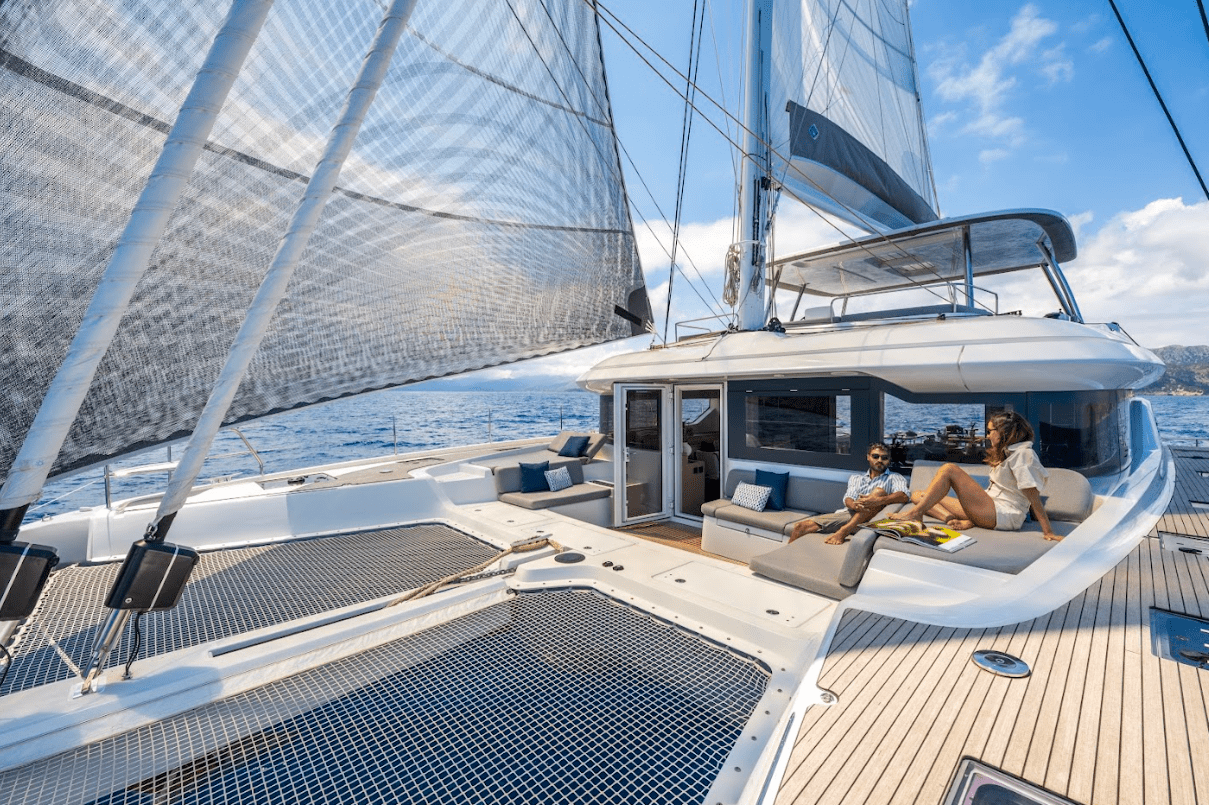 The cutter rig features a staysail and genoa at the ready – plus a code 0.
The cutter rig features a staysail and genoa at the ready – plus a code 0.
A Lengthy Development
Numbers alone don’t capture the nuances of this new model. Belmont shared that it took two years of development to balance satisfactory sailing performance with the pinnacle of yacht comfort.
Integrating the massive cockpit-terrace lounge with the forward cockpit was a considerable challenge. The central bay window opens to its full width, and the elimination of the aft beam enables an unobstructed view over the water.
The entire structure is designed to enhance platform rigidity, increasing resistance to torsional forces. The return to a forward-stepped rig provides numerous advantages: a more forgiving and powerful sail plan in light chop, a more open saloon due to the mast compression post being removed, and an unobstructed flybridge.
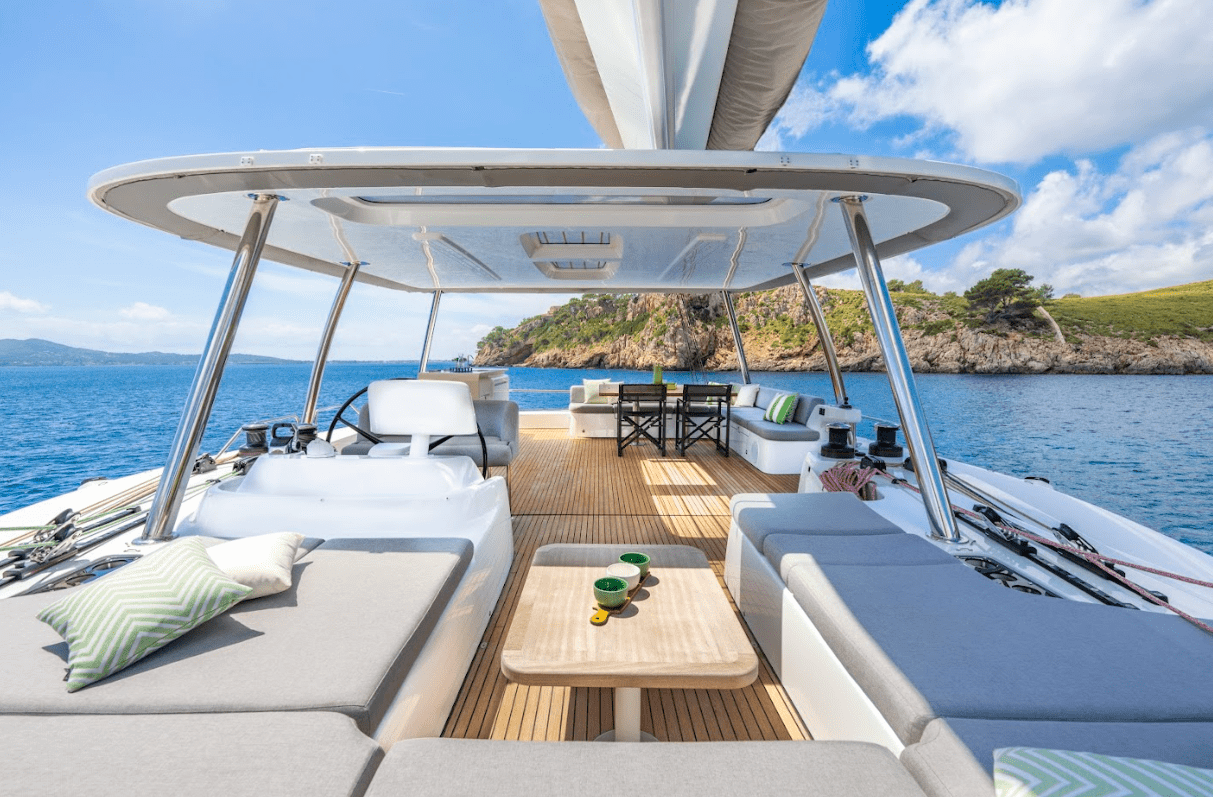 The Lagoon 60’s flybridge is vast, among the largest in its class.
The Lagoon 60’s flybridge is vast, among the largest in its class.
The established specifications were explicit: the Lagoon 60 needed to remain a user-friendly catamaran, easy to operate, and more energy-efficient.
For the powertrain, Yanmar was tasked with creating a dedicated 150hp engine integrated with a sail-drive transmission, providing a space-saving and more reliable arrangement than a V-drive.
The chilled-water air-conditioning operates at 25% less energy, designed to function all night on the lithium battery bank. With two 125A alternators per engine, the generator only needs to operate for eight hours within a 24-hour cycle to fulfill significant onboard ‘hotel’ requirements.
Ease of Use And Versatility
All technical components have been meticulously designed to maximize onboard comfort, prioritizing ergonomics and modularity. The Lagoon 60 boasts features drawn directly from the premium Lagoon SIXTY/SEVENTY range.
 The platform and stairs allow for easy water access.
The platform and stairs allow for easy water access.
Getting around onboard is straightforward, thanks to a thoughtfully designed circulation layout. The 45-degree flybridge companionway features wide steps suitable for two-way traffic, and the single-level flooring enhances convenience.
The aft terrace, with its large modular table and fold-down wings for easier boarding at the dock, is a triumph. The full-width bathing platform is an essential feature. The saloon impresses, especially in the galley-down configuration, which includes a counter/bar area that seamlessly blends indoor and outdoor hosting. The table and sofa provide a comfortable setting with an unobstructed sea view.
The forward sunbathing area on the flybridge is exceptionally inviting. Beneath the hardtop, the expansive space can be customized to the owner’s preference, with a range of options available. Cabin configurations of four or five depend on whether the galley is located down or up. The owner enjoys a suite with direct access to the aft deck.
Storage options are both abundant and spacious, and high-quality finishes, such as oak Alpi, abound. The customization options guide spans an impressive 150 pages for selecting finishes and accessories.
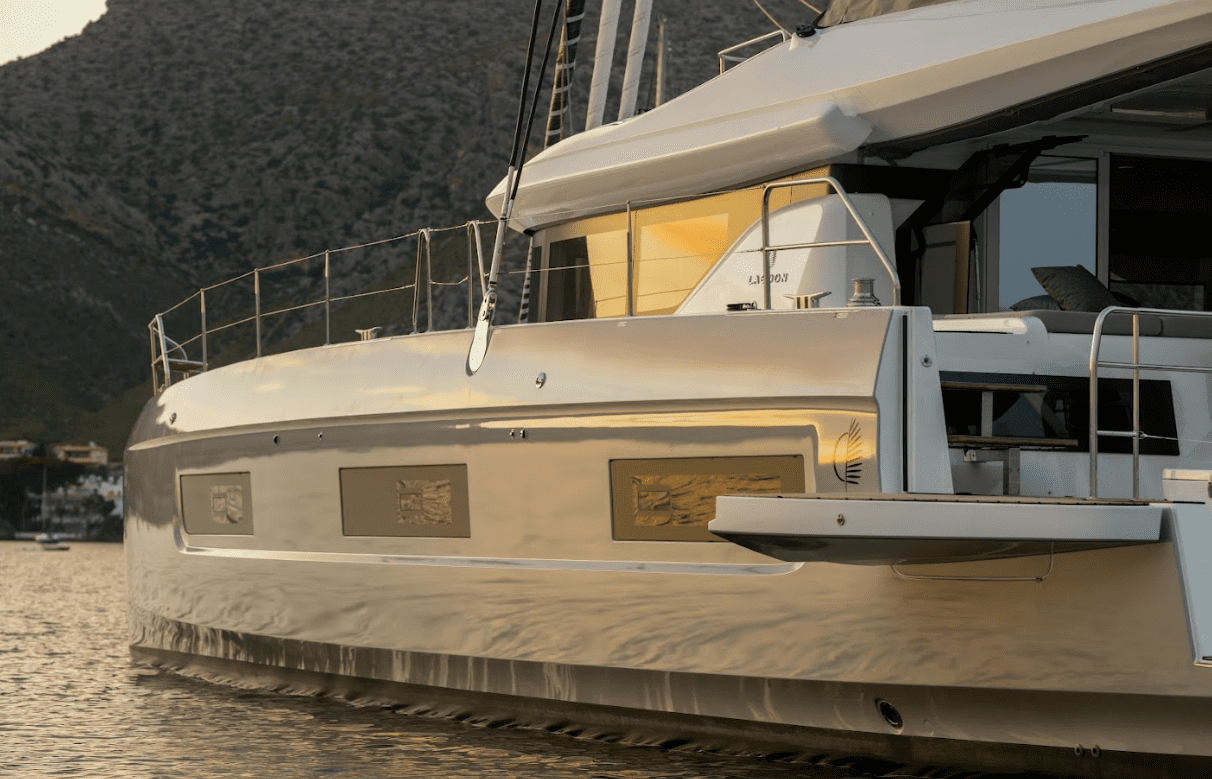 The aft cockpit serves as a spacious terrace with an unobstructed view of the sea.
The aft cockpit serves as a spacious terrace with an unobstructed view of the sea.
Power and Stability
This comfort does come with a higher displacement (34 tonnes compared to 30 tonnes for the Lagoon 620 and 28.2 tonnes for the Fountaine Pajot Samana 59). With an upwind sail area of 233 square meters, the sail area-to-weight ratio is 6.85 sqm/t (7.67 sqm/t for the Lagoon 620 and 7.23 sqm/t for the Samana 59).
Would the Lagoon 60 be equipped to handle the light winds during our test? “Performance of a cruising catamaran is dictated not just by the power-to-weight threshold,” Belmont cautioned. “The hull shape and prismatic coefficient are also crucial.”
Your preference will guide your choice: long, thrilling jaunts at over 20 knots, or a comfortable average speed across varying conditions? At first glance, the Lagoon 60 seems suited more for the latter.
After setting the sails, our multihull glided over a slight swell. Our GPS tracked its acceleration, and the Lagoon 60 eventually stabilized at 8 knots, even though the true wind barely reached 10 knots.
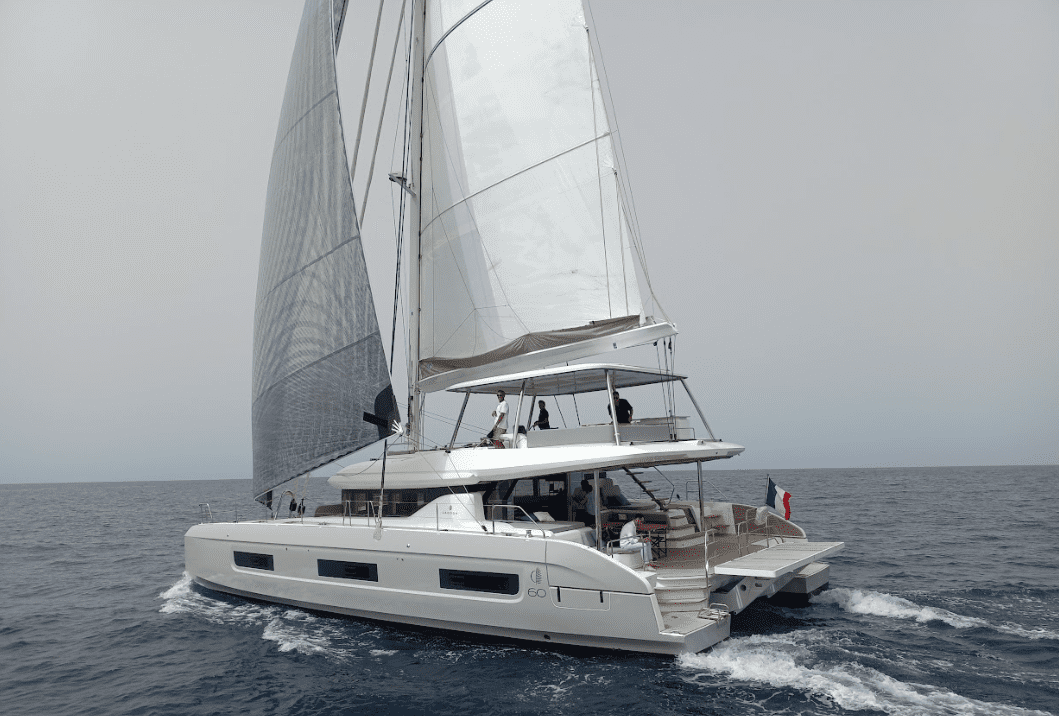 The catamaran registered 8 knots on the GPS with 10 knots of true wind.
The catamaran registered 8 knots on the GPS with 10 knots of true wind.
The power offered by the gennaker contributes to stabilizing this appealing speed, as the hulls glide smoothly over the waves. In light conditions, it was evident that this large catamaran can perform admirably once it gains momentum. The structural rigidity was very apparent beneath our feet.
When it’s time to lower the sails, you must go up to furl the main in the beautiful Lorima canoe boom; however, it’s unfortunate that a furling boom isn’t (yet) part of the listed options.
Lastly, the discreetly mounted engines at the stern present a significant advantage for maintaining an average speed of eight knots in calm conditions.
Modern cruising catamarans are increasingly complex as buyers seek more comfort. Lagoon’s designers recognize this trend and have successfully fused usability with exceptional comfort.
The Lagoon 60 benefits from insights gained from the Premium range: with just a bit more length, it could easily qualify as a superyacht.
Images courtesy of Lagoon and the author.
catamarans-lagoon.com
asiamarine.com
This article first appeared on Yachtstyle.Co.
For the latest yachting updates, click here.






